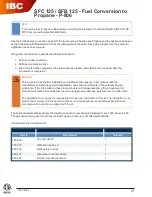
11-03
EP E
series
Illustrations may differ from the actual product
Allowing for printing errors and errors on proofs
13
Bleeding/filling
Regularly check that there is sufficient water in the heating sys-
tem. Air may remain in the heating system for a while after instal-
lation, so bleeding should be repeated a few times. After bleeding,
check the pressure and add water if necessary.
Overheat protection
The boiler has two or three overheat protection devices that are
triggered when the boiler temperature exceeds approx. 100°C. The
protection is reset behind screws on the front panel. You can reset
when the temperature has fallen below 80°C.
Excess temperature protection:
The electronic control system has an excess temperature function to
complement the overheat protection.
The purpose of excess temperature protection is to disconnect all
power if there is a temporary temperature increase, for example
resulting from sudden loss of flow through the boiler caused by
pump failure, etc. If excess temperature is detected, all power stages
are disconnected immediately. Once the temperature has fallen
below the setting, the power is reconnected in stages – no reset is
necessary.
The function is triggered if the boiler temperature exceeds the
setting by more than 5 °C.
Safety valve
If a closed expansion system is used, the safety valve installed in the
heating system must be operated regularly, around four times a year,
in order to preserve the safety function.
Draining
When you drain the system, you must first disconnect the power
supply to the boiler to avoid damaging the immersion heater.
If there is a risk of freezing
In severe cold weather, no part of the heating system should be
turned off as this would involve a risk of burst pipes.
Call the installer if you suspect that any part of the heating system
might be frozen.
If the heating system will be turned off for an extended period, the
water should be drained.
After installation, check with the installer that the system is in
perfect condition.
Ask the installer to demonstrate the settings and functions so you
know exactly how to operate and care for the system.
Check the water pressure – air may remain in the system for a
while after installation, so you should check the pressure again a
few times.
Check that no tools, etc. have been dropped or left in the
connection area.
Check that the boiler and heating system are filled with water
before using the boiler.
Always disconnect the power supply to the boiler
before:
• draining the boiler water
• accessing the automation cabinet or units powered
by the boiler
Startup
1. Set the required boiler temperature.
2. Move the main and/or control switch to the on position.
The power/status light should start flashing.
3. Because the boiler has been without power, only three power
stages are connected. The remaining power is connected, if
necessary, after an hour.
The delayed reconnection can be disabled temporarily for
servicing and testing by pressing and holding the "SNABB" [FAST]
button until the status light stops flashing.
4. The boiler now connects the necessary number of power stages
until the temperature reaches the setting.
To reduce the connection time, keep "SNABB" [FAST] pressed.
Delayed reconnection
50% of the power is connected immediately, with the rest delayed
for an hour. This means that if power is lost for longer than three
minutes, only three of the power stages are connected – the rest are
connected in steps an hour after the power is restored.
The delayed reconnection can be disabled temporarily for servicing
and testing by pressing and holding "SNABB" [FAST] until the status
light stops flashing.
6. Power/status light.
7. Temperature setting.
9. Indicator for power group one, approx. 15 % of power.
10. Indicator for power group two, approx. 30 % of power.
11. Indicator for power group three, approx. 55 % of power.
12. Alarm indicator, overheat protection triggered.
14. Control switch.
16. Reset overheat, only EP 42 E, power groups one and two.
17. Reset overheat.
EP 26 E: power groups one and two.
EP 42 E: half of power group three.
18. Reset overheat.
EP 26 E: power group three.
EP 42 E: half of power group three.
38. Thermometer.
Control panel
Operation and care
6
7
9
10
11
12
14
16
17
18
38


































